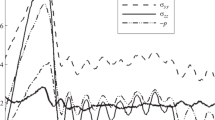Abstract
The critical J-integral is recognized as a valuable criterion for evaluating elastic-plastic fracture behavior of materials. It is, however, computationally complicated at the atomic scale for a nano-sized crystal when using the traditional integral method to reckon the traction force, strain, strain energy, etc. atom by atom. This paper attempts to propose an effective J-integral calculation method based on molecular dynamics (MD) simulations. The proposed method takes advantage of the potential energy interpretation of the J-integral, the main task in which is to calculate the potential energy difference of two identical crystal models with the neighboring crack length. As the potential energy of crystals at the atomic scale can be obtained easily from molecular dynamics simulations, the proposed method is thus computationally simple and especially applicable to complex crystal structures. A nickel crystal having an opening model I crack is investigated using this method. The critical J-integral in the ductile fracture plane (1\bar10) is calculated to be 4.424 Jm−2. It is also found in this study that the onset of crack propagation does not coincide with the occurrence of the maximum tension stress for nano-sized crystals, which is different from conventional fracture mechanics observation.
Similar content being viewed by others
References
Abraham, F.F. (2001). Crack Dynamics in Brittle Fracture: an Atomistic Study. Nucl. Instrum. Meth. B 180, 72–76.
Begley, J.A. and Landes, J.D. (1973). A Comparison of the J-integral Fracture Criterion With the Equivalent Energy Concept. Prog. Flaw Growth Fract. Toughness Testing, ASTM STP 536, 246–263.
Foiles, S.M., Baskes, M.I. and Daw, M.S. (1986). Embedded-atom-method functions for the fcc metals Cu, Ag, Au, Ni, Pd, Pt, and their alloys. Phys. Rev. B33(12), 7983–7991.
Hirosaki, N., Ogata, S. and Kitagawa, H. (1999). Molecular Dynamics Study of the Stress Distribution Near a Crack Tip in β-silicon Nitride. Mater. Sci. Res. Int. 5, 253–257.
Holland, D. and Marder, M. (1999). Cracks and Atoms. Adv. Mater. 11, 793–806.
Inoue, H., Akahoshi, Y. and Harada, S. (1994). A Fracture Parameter for Molecular Dynamics Method. International Journal of Fracture 66, 77–81.
Jon Rifkin (2000). XMD – Molecular Dynamics Program, Center for Materials Simulation, University of Connecticut.
Kitamura, T., Yashiro, K. and Ohtani, R. (1997). Atomic Simulation on Deformation and Fracture of Nano-Single Crystal of Nickel in Tension. JSMB Int. J. A, 40, 430–435.
Machova, A. (1996). Dynamic Microcrack Initiation in α-iron. Mater. Sci. Eng. A 206, 279–289.
Meguid, S.A. (1989). Engineering Fracture Mechanics, Elsevier Applied Science, London and New York.
Miller, R., Tadmor, E.B., Phillips, R. and Ortiz, M. (1998). Quasicontinuum Simulation of Fracture at the Atom Scale. Modelling Simui. Mater. Sci. Eng. 6, 607–638.
Nakamura, M. (1994). Elastic Properties, In Westbrook, J.H. and Fleischer, R.L., (Eds.), Intermetallic Compounds: Principles and Applications, 1, John Wiley & Sons Ltd, pp. 77–90.
Nobuyoshi Yanagida and Osamu Watanabe (1996). Molecular Dynamics Simulation of Effects of Lattice Orientation on Crack Propagation in Alpha-iron When the Primary Slip Direction Is in the Plane of Tensile Stress. JSME Int. J. A 39, 321–329.
Rice, J.R. (1968). A Path Independent Integral and the Approximate Analysis of Strain Concentration by Notches and Cracks. ASME J. Appl. Mech. 35, 379–386.
Ruth, M. Lynden-Bell (1994). Computer Simulations of Fracture at the Atomic Level. Science 263 1704–1705.
Tsuji, T. and Noda, N. (1991). Investigations of Stress Singularity and Distraction Mechanism in the Neighborhood of a V-notch Using Molecular Dynamics Method. Trans. Japan Soc. Mech. Eng. A 57, 2936–2941.
Voter, A.F. (1994). The Embedded-Atom Method, In Westbrook, J.H. and Fleischer, R.L. (Eds.), Intermetallic Compounds: Principles and Applications, 1, John Wiley & Sons Ltd, pp. 77–90.
Wunderlich, W. and Awaji, H. (2001). Molecular Dynamics – Simulation of the Fracture Toughness of Sapphire. Mater. Design 22, 53–59.
Xu, Y.G., Liu, G.R., Behdinan, K. and Fawaz, Z. (2004). Stepwise-Equilibrium and Adaptive Molecular Dynamics Simulation for Fracture Toughness of Single Crystals. J. Intel. Mater. Sys. Struct. (in press)
Zhou, S.J., Preston, D.L., Lomdahl, P.S. and Beazley, D.M. (1998). A Large-scale Molecular Dynamics Simulations of Dislocation Intersection in Copper. Science 279, 1525–1527.
Author information
Authors and Affiliations
Rights and permissions
About this article
Cite this article
Xu, Y., Behdinan, K. & Fawaz, Z. Molecular dynamics calculation of the J-integral fracture criterion for nano-sized crystals. International Journal of Fracture 130, 571–583 (2004). https://doi.org/10.1023/B:FRAC.0000049499.53799.b7
Issue Date:
DOI: https://doi.org/10.1023/B:FRAC.0000049499.53799.b7




